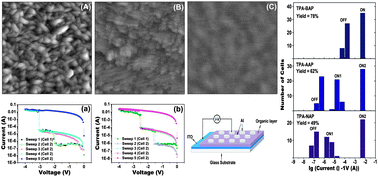a College of Chemistry, Chemical Engineering and Materials Science, China Petroleum and Chemical Industry key laboratory of organic wastewater adsorption treatment & resource, Soochow University, Suzhou 215123, P.R. China
b Key Lab of Lithium Ion Battery Materials of Jiangsu Province, Institute of Chemical Power Sources, Soochow University, Suzhou 215006, P.R. China
J. Mater. Chem. C 2013, 1, 3816-3824.
This study reports the syntheses, photophysical and electrochemical properties and memory characteristics of triphenylamine (TPA) donor based molecules with progressively weaker terminal acceptor strength (i.e., nitro, acetyl and bromine). The influence of the terminal electron acceptor strength on the film morphology and the devices storage performances was investigated. Nonvolatile ternary (“0”, “1” and “2” states) memory devices for high-density data storage could be achieved with a simple ITO/D–A molecule/Al sandwich configuration for TPA-NAP and TPA-AAP. It is noteworthy that the memory device based on TPA-AAP exhibited a better reproducibility and stability with lower operation voltages than that based on TPA-NAP, promising low-power consumption data-storage. These obtained results demonstrate that altering the terminal electron accepting strength in D–A molecules can adjust the film morphology and the device performances for the design of future advanced organic electronic devices.

链接: //pubs.rsc.org/en/content/articlelanding/2013/tc/c3tc30228h#!divAbstract